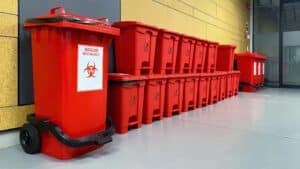All Points Medical Waste Blog
Hazardous Waste vs. Biohazardous Waste: What’s the Difference?
Why Every Healthcare Organization Must Understand The Distinction
Hazardous and biohazardous waste are common types of medical waste generated by healthcare facilities of all kinds. Proper disposal of these types of waste, just like all other categories, is crucial for the safety of healthcare workers, patients, and the environment.
And while these medical waste terms are often used interchangeably, they have distinct differences that require specific handling and disposal methods. Understanding these differences is essential for compliance, safety, and protecting the environment.
Hazardous Waste and Biohazardous Waste Defined
Hazardous Waste
Hazardous waste includes any waste material that poses a potential risk to human health or the environment because of its chemical, physical, or biological properties. According to the Environmental Protection Agency (EPA), hazardous waste can be separated into four categories:
- Ignitable: Items that are flammable, such as alcohol-based hand sanitizers or certain disinfectants.
- Corrosive: Substances like strong acids and bases used in laboratories and cleaning solutions.
- Reactive: Chemicals that can react violently, including certain sterilizing agents.
- Toxic: Waste that contains heavy metals like mercury from dental amalgams or lead from old medical equipment.
Biohazardous Waste
Biohazardous waste, also known as infectious waste, consists of materials contaminated with potentially infectious agents.
- Sharps: Including needles, scalpels, and syringes used in patient care.
- Human Waste: Blood, tissues, and other bodily fluids.
- Microbiological Waste: Cultures and lab samples containing infectious agents.
- Animal Waste: Contaminated carcasses or tissues from veterinary procedures.
Why Understanding the Differences Matters
Healthcare organizations must distinguish between hazardous and biohazardous waste to ensure compliance with federal and state regulations. Improper classification of these waste items can lead to:
- Risks to Public Health: Improper handling and disposal can lead to exposure to toxic substances or infectious diseases for healthcare workers and the public.
- Environmental Damage: Hazardous chemicals can leach into and contaminate soil and water, while infectious waste can contribute to the spread of diseases.
- Non-Compliance: Improper handling and disposal can result in violations of medical waste disposal regulations, leading to heavy fines and legal action.
Hazardous and Biohazardous Waste in Different Healthcare Settings
All healthcare facilities generate both hazardous and biohazardous waste. Here’s a look at the most common types for different medical providers:
Dental Practices
- Hazardous Waste: Amalgam containing mercury, lead aprons, and X-ray chemicals.
- Biohazardous Waste: Extracted teeth with blood, used gauze, and contaminated gloves.
Physician’s Offices
- Hazardous Waste: Expired or unused medications, certain types of cleaning chemicals, and disinfectants.
- Biohazardous Waste: Used syringes, blood-soaked bandages, wound dressings, and more.
Surgery Centers
- Hazardous Waste: Anesthetic agents, chemotherapy drugs.
- Biohazardous Waste: Removed tissues, surgical gloves, gowns, bandages, and contaminated surgical instruments.
Veterinary Offices
- Hazardous Waste: Pesticides, types of animal medications, and disinfectants.
- Biohazardous Waste: Used syringes, infected animal tissues, body fluids, and blood samples.
Clinics and Labs
- Hazardous Waste: Chemicals used for testing, solvents, and radioactive waste from diagnostic testing.
- Biohazardous Waste: Biological cultures, human tissue samples, and used testing tools.
Proper Storage and Disposal of Hazardous and Biohazardous Waste
All medical waste must be collected, stored, and disposed of properly to ensure the protection of patients, staff, and visitors while maintaining compliance with state and federal mandates.
Storing Hazardous Waste
- Store in designated, clearly labeled containers that are leak- and spill-resistant.
- Keep in a secure area away from heat or ignition sources.
- Separate incompatible chemicals to prevent dangerous reactions.
Storing Biohazardous Waste
- Use red biohazard bags for non-sharp items like gauze, bandages, and gloves.
- Store sharps in puncture-resistant, labeled, and lockable containers.
The Importance of Proper Waste Disposal
Improper disposal of hazardous and biohazardous waste can pose the following risks:
- Threat to Public Health: Exposure to infectious waste can lead to the spread of infections and diseases.
- Damage to the Environment: Chemicals can contaminate air, water, and soil.
- Legal and Financial Consequences: Medical organizations can face violations, fines, and financial liability for improper disposal.
Healthcare facilities must follow protocols for hazardous and biohazardous waste disposal. Understanding the differences between these waste types helps ensure compliance with regulations, protects public health, and safeguards the environment. Partnering with a trusted medical waste disposal provider ensures that your facility remains compliant and safe.
All Points Medical Waste is a full-service medical waste disposal provider located in Stuart, Florida. We serve healthcare facilities across the state and can help you with all your medical waste disposal needs. Give us a call today or fill out this form to get a quick quote.


